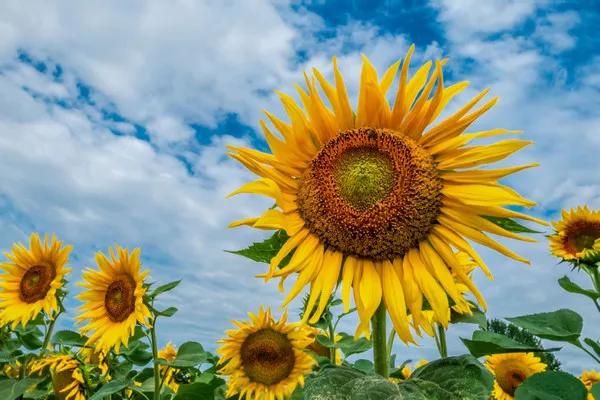Sunflowers, with their vibrant hues and captivating beauty, stand as iconic symbols of sunshine and warmth. The diversity within the sunflower family is vast, ranging from the classic bright yellow blooms to lesser-known varieties with unique characteristics. This article celebrates the brilliance of sunflowers by exploring the eight most common sunflower species. From the towering Giant Sunflower to the delicate Jerusalem Artichoke, each of these sunflowers contributes to the tapestry of nature’s splendor.
8 Most Common Sunflowers on Earth
1. Giant Sunflower (Helianthus annuus) – Majestic Monarchs of the Garden
The Giant Sunflower, or Helianthus annuus, is a quintessential representation of the sunflower family. Known for its towering height, often reaching up to 15 feet, and its large, golden-yellow petals surrounding a dark chocolate center, this sunflower is a staple in gardens worldwide. Its resilience and cheerful appearance make it a favorite among gardeners seeking a touch of sunlit grandeur.
2. Dwarf Sunflower (Helianthus annuus var. nanus) – Petite Prettiness
In contrast to its towering relative, the Dwarf Sunflower, a variety of Helianthus annuus, is a compact and charming addition to gardens. With heights typically ranging from 1 to 2 feet, these sunflowers boast the same golden-yellow radiance but in a more manageable size. Ideal for small spaces and container gardening, the Dwarf Sunflower proves that size does not diminish the impact of sunflower beauty.
3. Common Sunflower (Helianthus debilis) – Prolific Perennials
The Common Sunflower, or Helianthus debilis, graces landscapes as a hardy perennial species. Characterized by its ability to thrive in various conditions, this sunflower produces numerous bright blooms, each showcasing the classic yellow and brown color scheme. Adaptable and enduring, the Common Sunflower symbolizes the resilience embedded in the sunflower family.
4. Maximilian Sunflower (Helianthus maximiliani) – Autumn’s Golden Crown
As summer transitions to autumn, the Maximilian Sunflower emerges as a testament to seasonal beauty. Helianthus maximiliani, with its striking golden petals and bushy appearance, adorns gardens and natural landscapes alike. This perennial sunflower not only adds visual appeal but also provides a late-season nectar source for pollinators, ensuring its ecological significance.
5. Jerusalem Artichoke (Helianthus tuberosus) – Sunflower of Sustenance
Distinct from the traditional ornamental sunflowers, the Jerusalem Artichoke, or Helianthus tuberosus, offers both aesthetic and culinary allure. This sunflower variety produces tuberous roots, known as sunchokes, which are edible and have a sweet, nutty flavor. With bright yellow blooms, this dual-purpose sunflower holds a unique place among its sunflower counterparts.
6. Red Sunflower (Helianthus annuus ‘Red Sun’) – Fiery Flair
For those seeking a departure from the traditional yellow palette, the Red Sunflower (Helianthus annuus ‘Red Sun’) introduces a burst of fiery flair. Characterized by deep red and mahogany tones, this cultivar of the Giant Sunflower adds a dramatic touch to gardens. Its rich hues make it a striking choice for floral arrangements and a standout in sunflower collections.
7. Prairie Sunflower (Helianthus petiolaris) – Wildflower Whimsy
Native to North American prairies, the Prairie Sunflower, or Helianthus petiolaris, embodies the untamed beauty of the wild. With slender petals and a contrasting dark center, this sunflower thrives in natural landscapes, contributing to the biodiversity of native ecosystems. Its presence brings a touch of whimsy reminiscent of sunlit meadows.
8. Italian White Sunflower (Helianthus annuus ‘Italian White’) – Elegance in White
Breaking away from the traditional yellow and red hues, the Italian White Sunflower (Helianthus annuus ‘Italian White’) introduces an element of serene sophistication. With creamy white petals surrounding a dark center, this cultivar offers a subtle and elegant alternative. Its purity and grace make it a favorite for those seeking a softer sunflower aesthetic.
Conclusion
In the realm of sunflowers, these eight species stand as ambassadors of nature’s brilliance. From the towering Giant Sunflower to the culinary delights of the Jerusalem Artichoke, each variety contributes to the rich tapestry of colors, shapes, and sizes within the sunflower family. As we explore these common sunflowers, we gain a deeper appreciation for their resilience, adaptability, and the sheer joy they bring to gardens and landscapes around the world.
See Also: 10 MOST USED SPICES IN THE WORLD
You Might Be Interested In:





















